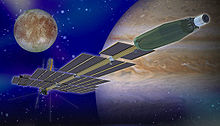Jupiter Icy Moons Orbiter
The Jupiter Icy Moons Orbiter ( JIMO ) was the flagship of the Prometheus project , restarted in 2003 , which aims to develop nuclear engines and energy sources for a future generation of space probes . According to NASA , the goal of JIMO was to construct and launch a completely new type of probe powered by a nuclear reactor for the exploration of the ice moons Ganymede , Callisto and Europa of Jupiter . The mission should start in 2017 at the earliest and has now been postponed indefinitely or canceled entirely.
target
The aim of the mission was primarily to explore the water oceans suspected under the surface of these moons (see extraterrestrial ocean ). Due to the tidal forces of Jupiter, not only liquid water, but also primitive life could have formed under the ice sheets , which uses the geological activity of the lunar interior as an energy source and which is protected from the strong radiation effects of Jupiter by the several kilometers thick ice sheets .
The new, high-performance energy supply created completely new possibilities. So a strong radar should be used to look deep into the ice sheet. The equipment of the probe should probably also include a laser height measurement for examining the height relief, various cameras, a magnetometer and dust detectors. The mobility and cruising speed should also be increased significantly by a nuclear-powered ion engine . The mass of the probe with approx. 26 tons should also be well above the previous interplanetary missions, in which Cassini-Huygens is the heaviest US space probe with 5.6 tons. According to NASA plans, only 1500 kg of this enormous mass were scientific payloads, the remaining mass would be used for the components of the nuclear drive, such as radiation shielding and heat radiators.
It was also planned to drop a lander on Europe. He could have tried to drill his way through the ice sheet with his instruments to reach the ocean below. However, it must be ensured that the lander does not contaminate any existing ecosystem with terrestrial bacteria, i.e. is completely sterile.
At the same time, JIMO was to be the technological pioneer for further missions into deep space. The exploration of Saturn's moon Titan, the planet Neptune, the Kuiper belt and the heliopause , the limit of the solar system , are on the agenda .
development
On June 10, 2003, an order to develop a concept study for the Europa-Lander with a volume of 9 million US dollars was awarded to the technology group Lockheed Martin .
On September 21, 2004, NASA's Jet Propulsion Laboratory commissioned the US defense and space company Northrop Grumman to develop hardware and software for the non-nuclear part of the spacecraft by 2008. The $ 400 million contract includes the development of the spaceship's internal controls, the energy supply and research facilities.
At the beginning of February 2005, NASA presented its budget proposal for 2006. Accordingly, the development of the Jupiter Icy Moons Orbiter project was put on hold for the time being, as the mission was supposedly too ambitious for the first test of the nuclear drive. The work on the Prometheus project continues, however, and a smaller test mission is currently being sought. The cost of the probe has been estimated at over $ 16 billion and the launch cost has been estimated at an additional $ 5 billion.
Spacecraft projects after the JIMO mission was canceled
A joint NASA / ESA Europe Jupiter System mission with two space probes was planned to replace part of the JIMO mission . The spacecraft that was supposed to orbit Europe would likely have had traditional energy supplies ( RTGs ) and the other (which was supposed to orbit Ganymede) would have had solar panels . However, after budget cuts, NASA also withdrew from this project. As a result, ESA decided to launch its own orbiter with a slightly modified flight plan for exploring Jupiter, its magnetosphere, Europa, Callistos and Ganymede under the name JUICE .
The Juno space probe decided in 2005 , however, was created completely independently of the stop of the JIMO program. With the study of the atmosphere and magnetosphere of Jupiter, Juno pursues different research goals than JIMO and is supposed to orbit the planet in a polar orbit, whereas JIMO would have moved near the equatorial plane of Jupiter to study the moons . Juno uses a conventional chemical propulsion system and is the first space probe on Jupiter to generate its electrical energy from solar cells. The use of solar cells is possible because Juno is on a polar orbit that is favorable for solar energy generation, mostly outside of Jupiter's strong radiation belt . A mission to the inner moons of Jupiter would continue to rely on a nuclear energy supply, since the strong radiation would destroy the solar cells.
See also
Web links
- Project Prometheus final report (2005 )
- Mission objectives in detail
- JIMO: Navy could become an important partner for NASA
- Contract award for the Europa-Orbiter
Individual evidence
- ↑ Nature 431, p. 113 (2004)
- ↑ [1]
- ↑ NASA: Prometheus Project - Final Report ( Memento of the original from March 4, 2016 in the Internet Archive ) Info: The archive link was inserted automatically and has not yet been checked. Please check the original and archive link according to the instructions and then remove this notice. , Page 178





